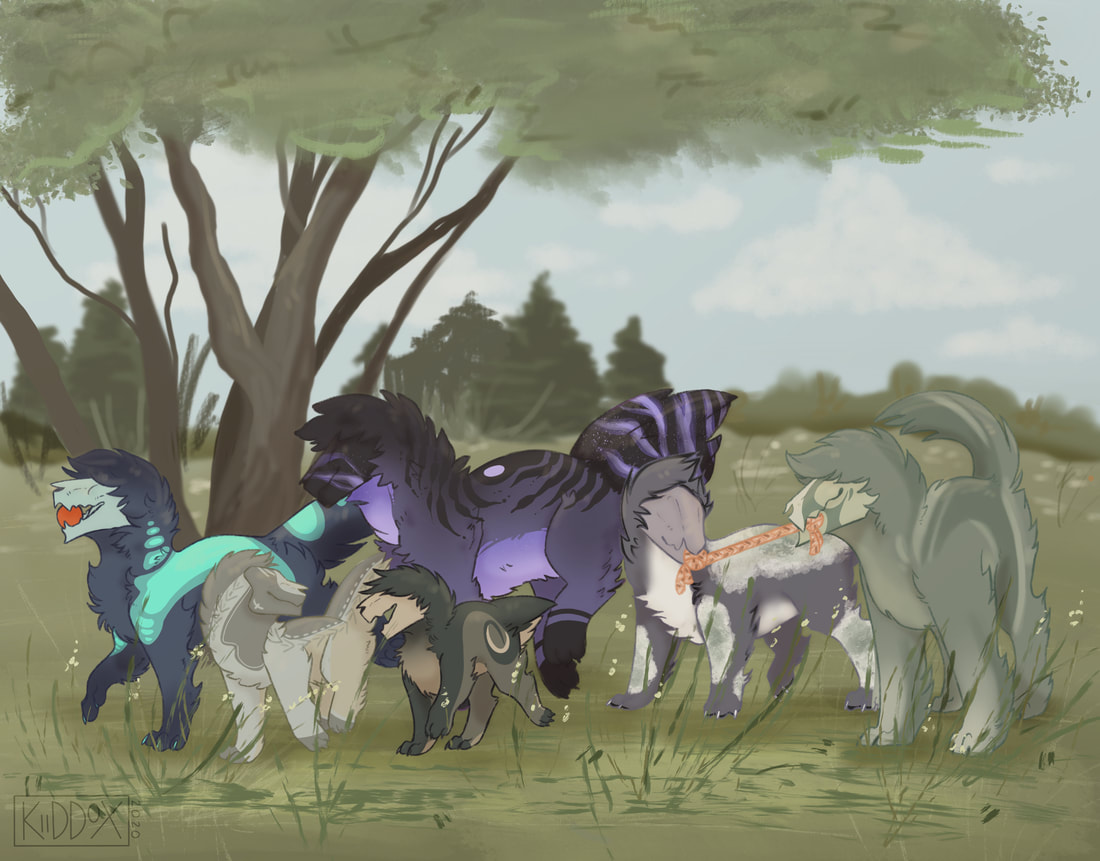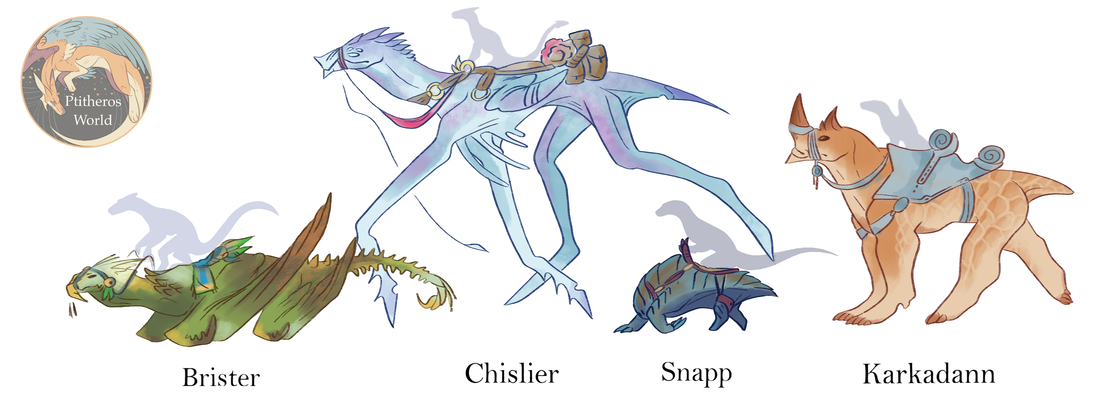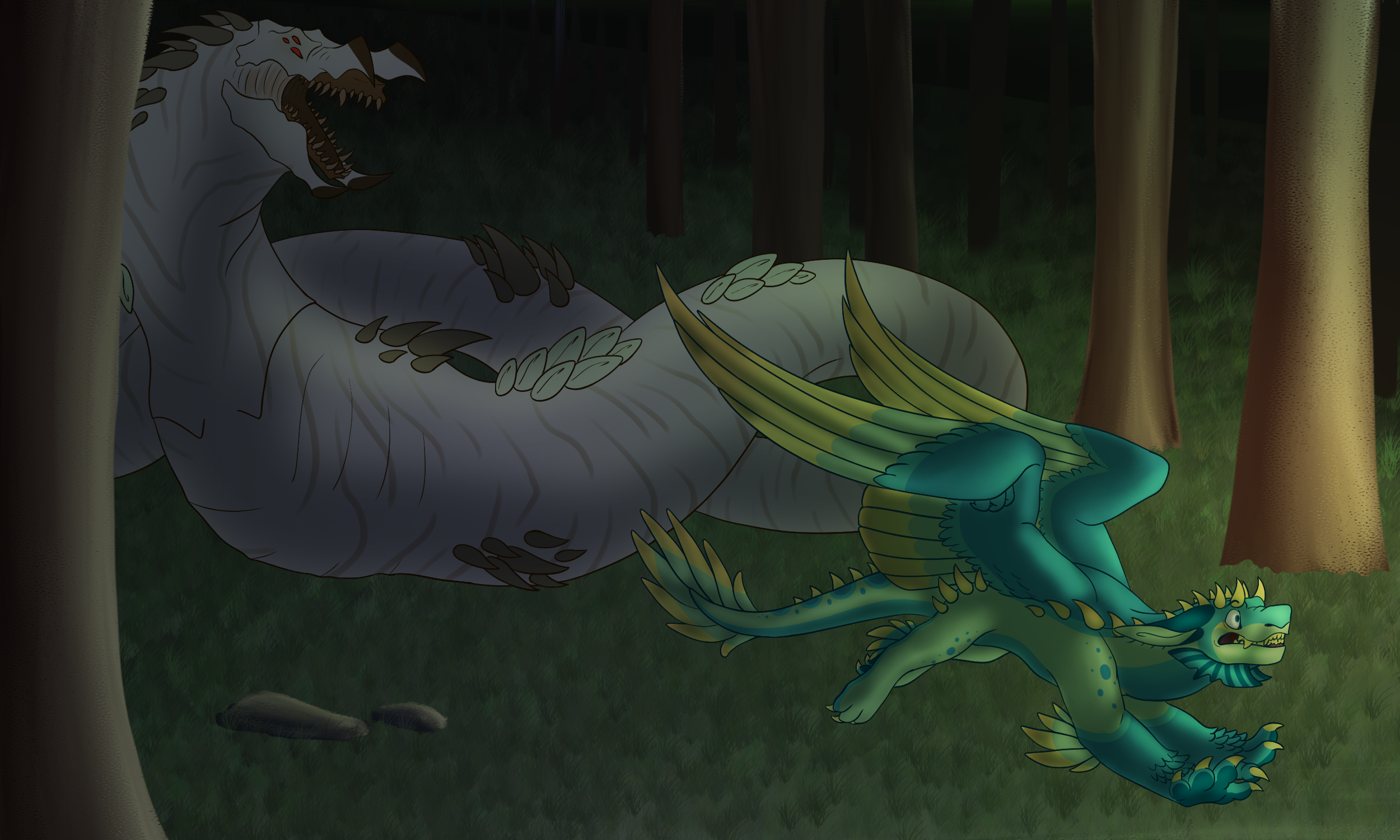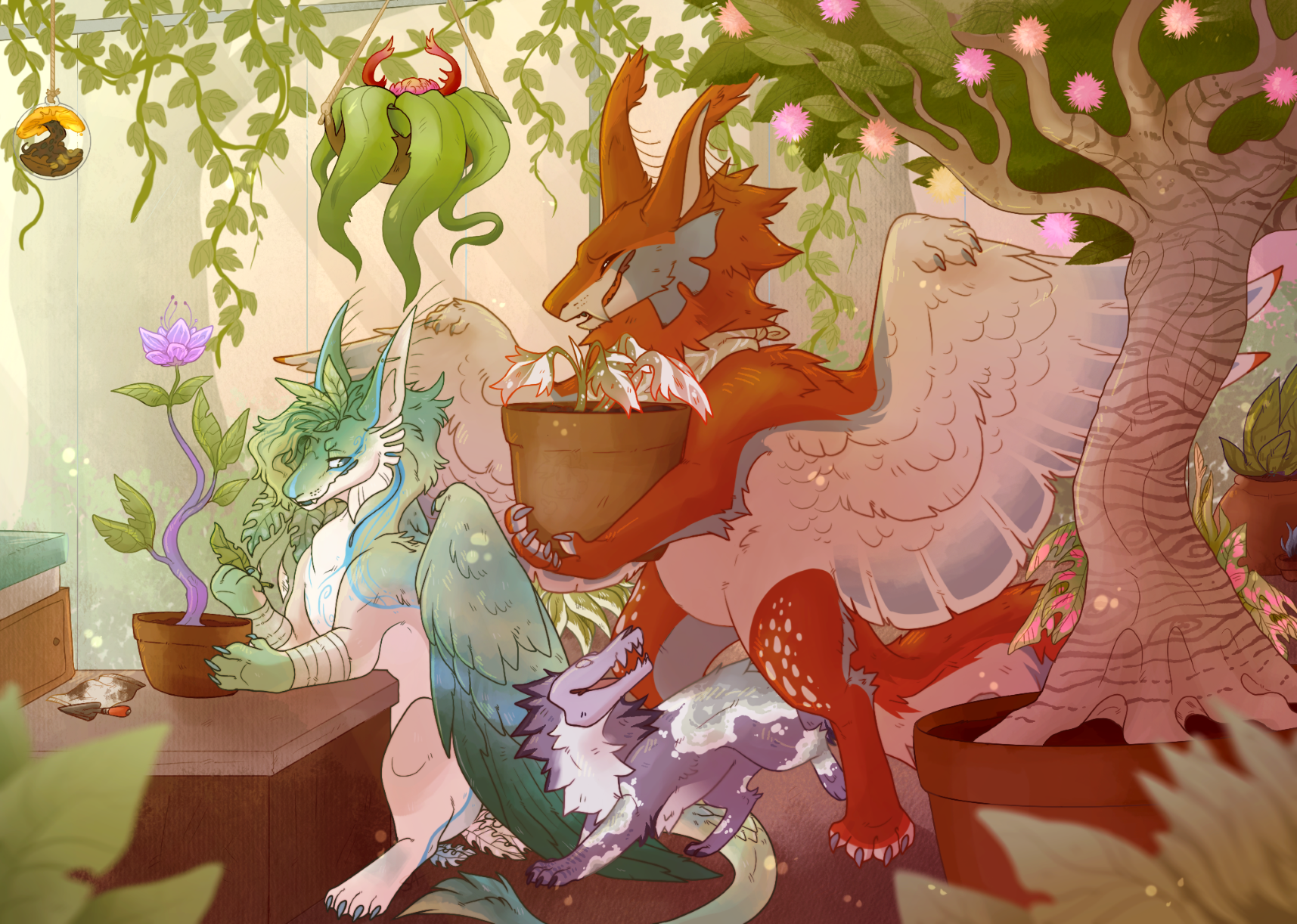Companions
Obtaining a Companion
Tions, Fens, Moshu, & Snapps - free to make! Stick to their design rules and submit as many as you want. A tion, fen, moshu, or snapp submitted must have an owner assigned when sent in.
Baluus, Faellers, Karkdanns, Chisliers, Brirsters, Seavelles, & Ursaldons - requires a Companion Tablet. Can be purchased at the Caq shop or won from events and raffles.
Pet Companions
Tion
(Fully domesticated) Tions were originally domesticated to be hunting partners. They are carnivores that can survive in a large range of climates and housing situations. A tion has to be adjusted to living with a Ptithian from a young age so they can associate their master as the leader of their "pack", making them naturally loyal and protective over them. In the past, a tion pup would be taken from a wild mother and raised manually. Nowadays, it's easier to get a pup from a breeder or shelter, which are places that tions who have been domesticated for generations can be found. These tions/tion pups are more docile and easier to train. A tion has to be fed a diet of meat and some grain, need ample space to run, and require attention from their master due to their pack instincts. A tion separated from a pack (their master or master's family) get horrible separation anxiety.
Learn about their wild counterpart.

Fen
(Fully domesicated) Fens are the "cats" of Ptitheros. These small carnivores live in warm enviorments and hunt pests. They were naturally domesticated by adapting to city and town life, making them constantly live near Ptithians. They got used to them and became fearless of them, causing them to enter homes and buildings. Nowadays fens are kept as pets by Ptithians, even though most fens couldn't care less about a Ptithian giving them free food and a bed. Most fens do not take orders and are not helpful like a tion can be.
Learn about their wild counterpart.

Baluu
(Tamed) Baluus are small amphibians that can be found as pets in wet or forest-y locations. They are low-to-the-ground creatures, slow, don't eat much, and can follow very simple commands if taught correctly. They enjoy the presence of Ptithians and like to, very slowly, follow their master around the house. Baluus have a unique ability that can make them useful in certain situations and professions. Called the "walking backpack" for a reason; a baluu can eat anything and store it in what seems to be a black hole in their stomach. Scientifically it's just an ever-stretching organ attached to their stomach. Any item can be put in there, so for an explorer, they can feed their baluu most of their supplies, then just bring the baluu with them.
Learn about their wild counterpart.

Faeller
(Tamed) Faellers are avian carnivores that usually stay away from Ptithians. However, a form of falconry exists in Ptitheros. Faellers can be raised from an egg and trained using food to catch prey or watch over locations for their handlers. Unlike other companions, faellers are not fully domesticated and have an agenda of their own if they choose so. A faeller who feels bored or poorly taken care off will leave the first chance they get. A faeller being loyal to a handler is rare, they are merely useful so long as they get their fair share.
Learn about their wild counterpart.

Moshu
Moshu are small auravores that reside in any wet climate. They can also be found on the ocean floor. They are fully docile and easily tamed, many living in households were simply plucked from ponds or tidepools. As auravores, they lack most biological functions besides an intelligence system. They can’t die unless completely dried out or from old age. They come in a variety of shapes and colors and breeders offer some of the rarest appearances. Moshu found inland are often more soft and frilly, while oceanic ones are spikey. Moshu cannot speak for themselves but are telepathic, they can hear the thoughts and words of intelligent animals and recreate them in a watery-static-esce voice. This makes them useful service animals for the deaf or mute, as a moshu carried with them can speak for the ptithian. Tamed moshu that have spent a lot of time with a single owner can learn to communicate their own thoughts, however, these thoughts are only advanced as a tion’s: where they want to go, they want to be held, etc.
Learn about their wild counterpart.

Mount Companions
Despite Ptithians being very strong, able-bodied, and often flight-capable creatures, even they prefer to use the might of other animals to lessen their burdens. Many different creatures have been domesticated to some capacity over the years, but some have been assigned a common role known as Mount Companions. These companions are able to be ridden and usually can carry some cargo with them.

Snapp
(Fully domesticated) Snapps are one of the oldest domesticated species on Ptitheros, records of their use go back to the earliest eras but can be traced back to originally an animal from the Honeycomb Forest. It is likely the Chaverians domesticated the roly-poly beasts and have since distributed them across the continent through trade routes and transportation. Because of the snapps' unique defensive curling-up ability they became used as a form of biomechanical wheels for larger platforms. Early travelers figured out snapps could be trained to lift and carry wooden platforms that held many goods and roll up to travel much faster. More snapps added meant larger platforms, eventually leading to the large caravans and chariots that bring items and important individuals safely across vast landscapes. Snapps are also used as singular mounts for travelers and are able to pull their rider into their roll to protect their owner when something threatens them. Snapps can be used as building and caravan carries, cargo carries, personal mounts, taxi vehicles, and family pets.
Learn about their wild counterpart.
Chislier
(Fully domesticated) Chisliers were domesticated by those who lived on the edges of the Ulhar Caesin. These creatures are migratory, tall-standing, and docile. Those who tamed them did so in order to make use of their height, size, and speed. Able to run quickly on their lanky legs for short bursts, chisliers can carry light cargo and transport such from place to place at a adequate pace even with only one at disposal. Chisliers became popular all across the southern coastline, for the flat beaches and swamps with rising tides made land-travel with basic wheels difficult. The endless legs of the chiseler made water or dense vegetation no longer a problem. Chisliers are very docile and herd-oriented, making raising them often a family business of maintaining an entire herd. Chisliers removed from their herds for long amounts of time become stressed and less responsive to commands, eventually falling to the ground from heart failure due to anxiety. Chisliers can be used as trade cargo mounts, racing mounts, personal mounts, taxi mounts, patrol mounts, and therapy animals. Their thin legs make them capable of crossing through somewhat-dense cities if necessary but there are routes better suited for them.
Learn about their wild counterpart.
Karkadann
(Partially domesticated) Karkadanns were first domesticated by nomadic travelers out in the Meldra Desert in order to transport their dwellings and members. As these loose groups assimilated into the Tucruitorian cities over time these large beasts became used for merchants and messengers to cut time having to transport goods and mail. Karkadanns have not been changed much as domestication continued and tamed karkadanns can easily be released into the wild and will return to a feral state within a few years when lacking societal contact. Although a common sight when traveling desert roads or on the outer stables of Tucruitora and Solluhawh, karkadanns are still dangerous and must be treated with respect. With their massive size and high temperament, there is a track record of karkadanns piercing their owners with their horns when not treated nicely. Karkadanns can be used as trade cargo mounts, fighting mounts, personal mounts, taxi mounts, cavalry mounts, and demolition machines. They are not allowed within denser, inner cities due to their large size.
Learn about their wild counterpart.
Brirster
(Partially domesticated) Brirsters were domesticated by one of the early groups of Sequ'Manko. These creatures were once feared monsters, for they are carnivorous and are able to glide through the dense jungle trees with as much ease a jungle-raised dragon. Evolved from the same plant-based Animalia family as the infamous briar, the brirster has skin made of fleshy bark and a top side covered in grass. Durable, long-fingered, brief flight capable wings, and a flattened body. Brirsters are able to carry low amounts of cargo and are used to transport things through the jungle or other tree-heavy areas that other mounts cannot reach as often. Brirsters are essential to sustaining forts and posts set up in places in like Dark Briar Grove. Brirsters are rode on their shoulders, making them singular-person mounts, so most are used for personal transport or cavalry defense by the Mankians back when their kingdom stood strong. Brirsters can be used as low-weight cargo mounts, personal mounts, emergency rescue mounts, and cavalry mounts.
Learn about their wild counterpart.
Seavelle
Seavron-related mount, usually ridden as a pastime or sport (like sail boats) along coastlines as they would not be suitable for traveling on the open ocean. They have a tough, broad back and are roughly the size as a brirster. Can carry up to three ptithians and some (water-proofed) belongings. They are highly family-oriented; when one is being ridden, their family follows, so two ptithians together will often ride the mother and father. Seavelles are easily kept in small bays or coastal inlets. The creatures need to be trained to stay close to the surface while being ridden, but are capable of diving deep. If the rider can breathe underwater or has scuba gear then they will usually ride this mount fully submerged. Seazelles are trained to find things underwater for ptithians, as helpers to foragers and as transportation.
Learn about their wild counterpart.
Ursaldon
Ursaldons were partially-domesticated in an attempt to make travel across Psollo and frigid mountains safer. Sled-tions were loyal, but could not defend against larger beasts. In cold climates, ursaldons can keep their riders warm and can carry a solid amount of cargo. Their strength was desired elsewhere than Psollo though, so many were transported to the Galian highlands and more were dispersed into the temperate regions. In these warmer climates, they must be shaved down to avoid overheating. Wild ursaldons cannot survive anywhere outside of Psollo or high mountains, so those found in other regions always have an accompanying owner.
Learn about their wild counterpart.
Service Animals
Service animals are commonplace across Ptitheros. There are specialized training programs to teach companions how to assist different health complications that Ptithians can have. There are disability service animals, trained to help the blind, those with trouble walking, and more. There are emotional service animals, trained to alert panic attacks, aura imbalances, etc, and help soothe their masters.
Tions are the most common service/support animal due to their ease of training and widespread trust Ptithians across the globe have for them. Fens can also be trained, but finding the right fen who is willing is the difficult part. Baluus can only be emotional support, as unfortunately they pose no capabilities to help those with disabilities. Faellers are far too self centered and unreliable. Snapps are as easily trained as tions, but their size makes them less useful. Chisliers, karkadanns, and brirsters also suffer from the size downfall.
Tamed Monsters
Abuse Warning
Most monsters in Ptitheros are still regular animals, they just tend to be highly dangerous and above Ptithians in the food chain. These animals, when introduced to a master at hatching/birth, can be partially-tamed. These include briars (any type), greater gargyls, phantom echoers, tyvets, and boslodons.
Tamed beasts like these are generally not allowed in cities or places that are "pet-friendly". Monster trainers are more often found in underground markets, fighting rings, and anywhere known for worrisome activities. (This does not account for all monster trainers. Some live regular lives and just happen to have a brair as a companion, etc.)
Only in the darkest recesses of the criminal underground can "subdued monsters" be found. Subdued beasts are not tamed and can include sentient beasts/once-sentient. Windiage, vindiagos, scalaces, soyowas, even the extremely rare lindost whose energy had been ripped away. The worst of the worst use these captured monsters for fighting rings and as trophies.

Diets
Dragons, gryphons, lefikas, and rubasyns are all omivores. They can eat plants and meat to get their nutrients. Ptithians live in a highly complex world with various forms of agriculture and domestication to get the food and materials they need. Ptithians only eat naturally-occuring foods, they do not have lab-grown organisms (nor would they ever create any).
Lefikas and lefika mixes, because of their georegeneration ability, need to add geologic particles to their diet. This usually includes sand, silt, or fine gravel. In modern times, "rock spices" are very common in Tucruit cuisine. Lefikas require a lot more salt/sodium in their diet than other species.
Taroots are carnivores. They do not have grinding teeth and require meat to stay healthy. Taroots can eat other types of food and eat complex meals, they need plants for fiber and minerals, but cannot survive off of plants alone like the other species can. A taroot cannot be vegetarian/vegan.

Obtaining Food
Ptithians have created many forms of agriculture, domesicated many animals, are skilled foragers, hunters, and fishers. They get their food and resources in a variety of ways and know how to store or preserve their haul.
⇴ Farming | Gardening
:: the activity or business of growing crops and raising livestock.
:: the activity of tending and cultivating a garden, especially as a pastime.
⇴ Foraging
:: foraging is searching for wild food resources.
Any plants and raw materials that cannot be cultivated or gathered into a specific location must be foraged from the wilderness. Most rare minerals, mined metals, herbs, flowers, seeds and bugs are foraged.
⇴ Hunting
:: the activity of hunting wild animals or game, especially for food or sport.
Hunting for sport is a lot less common than for need. Only Ptithians with enough coin to never struggle with food have the time and resources to hunt for sport. Many ptithians frown on sport hunting because it is wasteful and just a show-off tactic.
⇴ Fishing
:: the activity of catching fish, either for food or as a sport.
Seaside towns that export fish are heavily reliant on it. Fishing for sport is more common in places along rivers because oceanic fishing is more profitable.
⇴ Domestication
:: the process of taming an animal and keeping it as a pet or on a farm.
Animal products like cheese, yogurt, leather, eggs, wool, etc. are all available across Ptitheros. Because these animals have not been subject to generations of worrisome selective breeding, "pet" animals are healthy and quite similar to their wild ancestors.
⇴ Cuisine
:: a style or method of cooking, especially as characteristic of a particular country, region, or establishment.
Ptithians have varying cuisine per culture and location, as large cities would have many more restraunts and advanced technology for creating and perserving food compared to smaller settlements.

Resource Regions
Each climate zone has its own plants and animals. These only account for native species or where a species was first domesticated, as Ptithians can grow anything in greenhouses across the planet and move animals around.
⤿ Coastal Regions
Farm, Forage, or Fish
- Coconuts
- Glaun (Rainbow Maize)
- Bugs, Insects
- Lobsters
- Khrabs (Crabs)
- Herring
- Tuna
- Prawns
- Ear Pins
- Jullun
- Navella
- Deslofox
- Pentoz
- Pulsing Gems
- Rbax
- Parodine
- Abrazum
- Mondrake
Hunt or Husbandry
- Foes and Sugar Foes
- Minituries
- Baluus
- Frillen
- Talonmimics
- Rpators
- Sleves
- Seavron
- Khrabs
- Snapps
- Chisliers
- Boslodons
- Jewelbels
Monsters
- Soyowas (Wurunwa Only)
- Phantom Echoers
⤿ Mid-Latitude Regions
Farm, Forage, or Fish
- Potatoes
- Apples
- Cucumbers
- Cabbage
- Squash
- Parsley
- Rosemary
- Lavender
- Thyme
- Saffron
- Bugs, Insects
- Salmon
- Trout
- Herring
- Pollos
- Rollin
- Glowbles
- Alistar
- Jullun
- Soluab
- Massox
- Lonomine
- Mondrake
- Adyfor
- Hanging Gills
- Minota
- Paminar
- Zolpifo
Hunt or Husbandry
- Foes and Sugar Foes
- Tions
- Lingerers
- Frillen
- Faellers
- Echoers
- Talonmimics
- Raptors
- Sleves
- Gargyl
- Tyvets
- Snapps
- Jewelbels
Monsters
- Briars
- Vindiagos
- Phantom Echoers
- Greater Gargyls
⤿ Tropical Regions
Farm, Forage, or Fish
- Watermelons
- Apples
- Cucumbers
- Cabbage
- Squash
- Coconut
- Coco (chocolate)
- Vanilla Beans
- Saffron
- Bugs, Insects
- Salmon
- Trout
- Herring
- Rollin
- Glowbles
- Adretre
- Soluab
- Featherdusters
- Terco
- Casbax
- Brimos
- Parodine
- Paminar
- Toinin
Hunt or Husbandry
- Foes and Sugar Foes
- Minituries
- Lingerers
- Ballus
- Echoers
- Talonmimics
- Raptors
- Sleves
- Brirsters
- Jewelbels
Monsters
- Briars
- Vindiagos
- Phantom Echoers
⤿ Arid Regions
Farm, Forage, or Fish
- Cactus
- Green Onions
- Bell Peppers
- Cabbage
- Soybeans
- Glaun (Rainbow Maize)
- Parsley
- Rosemary
- Watermelons
- Dates
- Thyme
- Fons
- Bugs, Insects
- Salmon
- Trout
- Arrowheads
- Adecine
- Allouve (Aloe)
- Domide
- Entrar
- Therac
- Ocytrac
- Abrudin
Hunt or Husbandry
- Foes and Sugar Foes
- Tions
- Fens
- Frillen
- Talonmimics
- Raptors
- Gargyl
- Jessels
- Tyvets
- Karkadanns
- Jewelbels
Monsters
- Briars (Sandwyrm)
- Wild Scalaces
- Greater Gargyl
⤿ Cold Regions
Farm, Forage, or Fish
- Spinach
- Carrots
- Kale
- Radishes
- Cabbage
- Broccoli
- Potatoes
- Parsnip
- Rutabaga
- Herring
- Lobster
- Alistar
- Deslofox
- Teslimus
- Adyfor
- Vinox
- Minota
- Prednin
Hunt or Husbandry
- Foes and Sugar Foes
- Tions
- Faellers
- Echoers
- Kallks
- Raptors
- Tufteles
- Jewelbels
Monsters
- Briars
- Windiage (Aurix Caesin Only)
- Phantom Echoers
Extra Notes
- Tions do not obey morshins unless it's a high mix taroot morshin. If they're too far from a pure taroot then they don't smell right and tions wouldn't recognize them as another tion that should be listened to.
- There is NO troublesome selective breeding on Ptitheros.
- Ptithians value work and effort to reach goals, they see any companion can accomplish something if given the time and training. The concept of playing Cardinal, despite having a good grasp on geneology, is only used to keep animals healthy.
- For example: They wouldn't breed strength into a tion, they'd train it. Naturally stronger tions are often chosen for these sort of jobs, but they are still naturally occurring. Ptithians would not look to selective breeding to "create" an animal how they want it. If an animal is healthy, that is all that matters.

